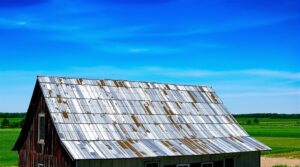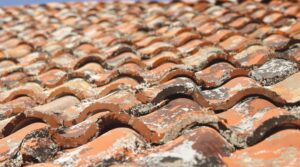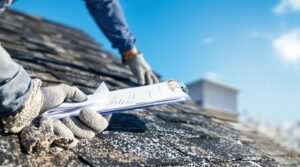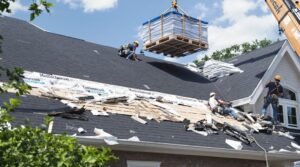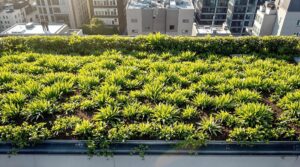Ever wondered why your "30-year roof" might not actually last three decades? Let's crack this roofing mystery together!
Think of your roof like a car – while it's advertised to run smoothly for years, real-world conditions tell a different story. Most 30-year roofs actually serve you faithfully for about 15 to 25 years, depending on how life treats them.
What's eating away at your roof's lifespan? Just like we age differently based on our lifestyle, your roof faces its own set of challenges. Mother Nature plays a huge role – those scorching summer rays, fierce storms, and wild temperature swings can really put your shingles through the wringer.
Your roof's actual lifespan is like a recipe with multiple ingredients:
- Installation quality (think of it as your roof's foundation)
- Local climate (your roof's daily environment)
- Maintenance routine (the TLC factor)
- Ventilation effectiveness (your roof's breathing system)
Want to squeeze every possible year out of your roof? Regular check-ups are your best friend. Just as you wouldn't skip your car's maintenance, your roof needs professional eyes on it periodically. This helps catch small issues before they become wallet-draining problems.
Remember, that "30-year" label is more of a warranty marker than a guarantee – it's essential to set realistic expectations for your roofing investment and plan accordingly for future replacements or insurance discussions.
Key Takeaways
Think Your 30-Year Roof Will Last Three Decades? Let's Talk Reality!
Ever wondered why your "30-year roof" might not make it to its promised milestone? Just like how a car's "lifetime warranty" doesn't mean it'll run forever, your roof's actual lifespan often tells a different story.
The Truth About Your Roof's Timeline
Your 30-year roof typically hangs in there for 15-25 years, max. It's like buying a smartphone with a 3-year protection plan – the warranty's one thing, real-world performance is another!
Mother Nature: Your Roof's Biggest Critic
Your roof faces a daily battle against the elements. Scorching sun, pounding rain, and extreme temperatures team up like neighborhood bullies, potentially cutting years off your roof's life. Think of it as weathering a constant outdoor obstacle course.
Staying Ahead of the Game
Want to squeeze every possible year out of your roof? Schedule checkups twice a year, just like you'd service your car. Regular maintenance isn't just about keeping your warranty valid – it's your roof's best defense against premature aging.
The Installation Factor
Remember this golden rule: your roof is only as good as the team that installed it. Poor installation can slash your roof's lifespan in half – imagine building a house of cards in a windstorm!
The Value Timeline
Your roof loses roughly 4% of its value each year, similar to how a new car depreciates when driven off the lot. This steady decline affects both its protective capabilities and insurance worth.
Understanding the "30-Year" Label in Roofing
When homeowners encounter the term "30-year roof," they often misinterpret it as a guarantee of three decades of service life. In reality, this label primarily refers to the manufacturer's warranty period for material defects and workmanship issues, not the actual lifespan of the roofing system.
The roof warranty coverage is specifically designed to address manufacturing defects and installation problems, typically shifting to pro-rated coverage after an initial period.
The actual life expectancy of various shingle types can range from 15 to 25 years, depending on factors such as roof pitch, sun exposure, and wind conditions.
To maintain valid warranty coverage, homeowners must conduct regular inspections and perform necessary maintenance. Understanding these distinctions helps set realistic expectations about roof longevity and warranty protection.
Signs of premature aging like curling and buckling should be documented and reported to insurance providers for potential coverage assessment.
Key Factors That Impact Your Roof's Actual Lifespan
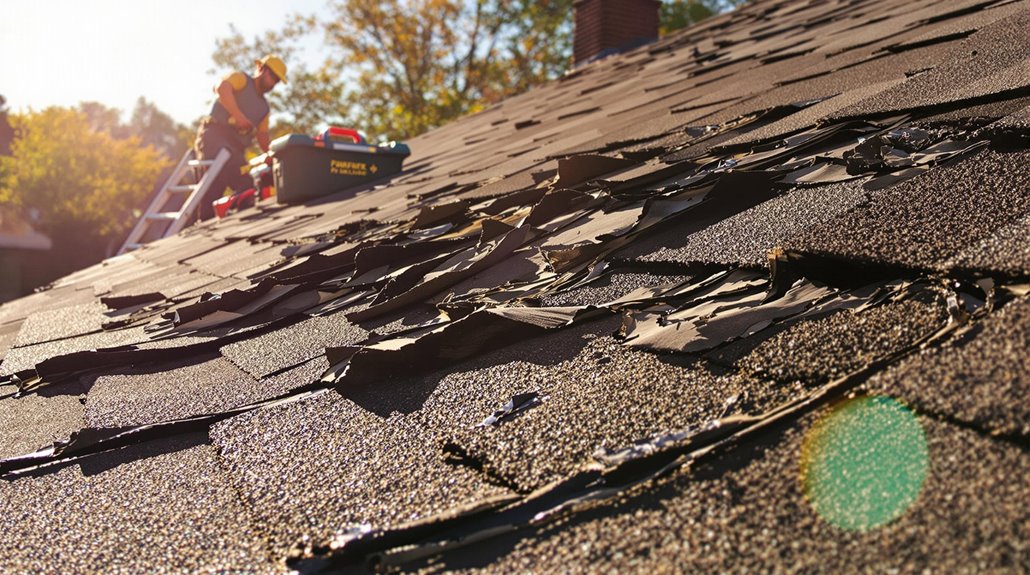
While a 30-year rated roof is engineered to last three decades, environmental conditions like extreme temperatures, heavy rainfall, and intense UV exposure can greatly accelerate wear and tear.
The quality of installation plays an equally critical role, as improper techniques or shortcuts during the installation process can lead to premature failures regardless of material quality.
Professional installation combined with regular maintenance helps guarantee ideal performance and longevity, potentially allowing a roof to reach or exceed its rated lifespan.
Signs like missing or curling shingles indicate it's time to evaluate replacement needs before more serious damage occurs.
Environmental Wear and Tear
Environmental factors greatly impact a 30-year roof's actual lifespan, often reducing its durability well before the anticipated three decades.
Extreme weather conditions, including high temperatures, hail, snow, and heavy rainfall, can accelerate the degradation of roofing materials. Sun exposure and varying humidity levels particularly affect cedar shake shingles, while asphalt shingles may experience granular loss from minor hail damage.
The geographic climate plays an essential role in determining roof longevity. While some materials like EPDM and metal demonstrate superior resistance to UV damage, all roofing materials eventually succumb to environmental wear.
Higher-pitched roofs typically offer better protection against weather elements, but regular maintenance remains vital. Professional inspections, prompt repairs, and proper ventilation can help mitigate environmental impacts and extend a roof's serviceable life.
Most roofs depreciate at 4 percent annually, significantly impacting their insurable value and replacement coverage options.
Installation Quality Matters
The quality of roof installation stands as the single most vital factor in determining whether a 30-year roof will achieve its expected lifespan. Professional installation techniques, combined with proper material selection, create the foundation for long-term durability. When contractors adhere to manufacturer specifications and employ precise installation methods, roofs consistently perform better and maintain their integrity over time. Public adjuster services can increase settlement amounts by up to 800% when installation-related damage occurs.
| Installation Factor | Impact on Roof Lifespan |
|---|---|
| Proper Fastening | Prevents shingle displacement |
| Correct Ventilation | Reduces heat damage |
| Quality Underlayment | Protects against moisture |
| Precise Alignment | Guarantees proper water runoff |
| Professional Workmanship | Maintains warranty validity |
Poor installation practices can void warranties and lead to premature failure, making professional installation vital for achieving the full 30-year potential of the roofing system.
Environmental Considerations and Regional Weather Effects
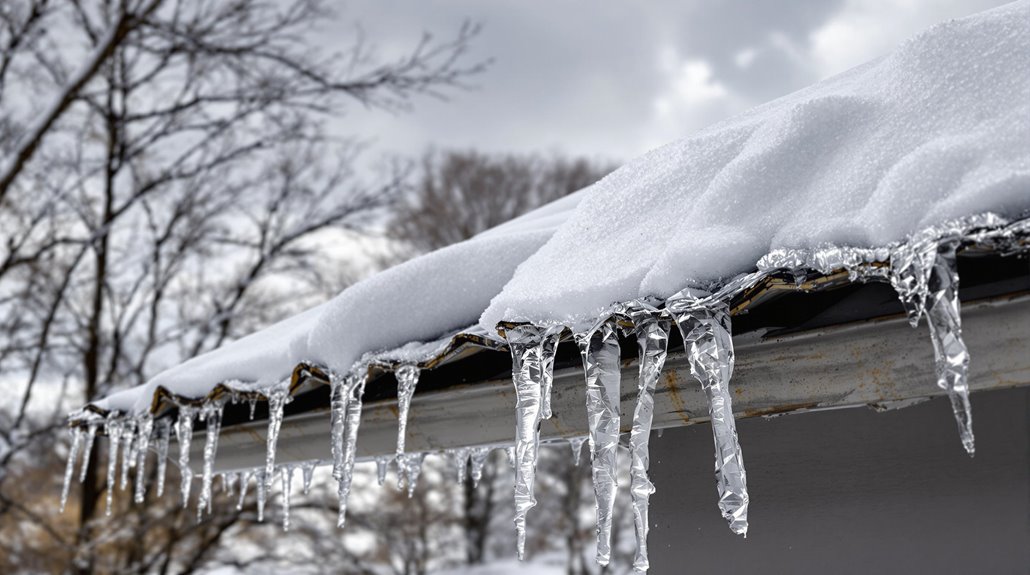
Regional climate patterns and weather conditions play a decisive role in determining how long a 30-year roof actually lasts. The climate impact varies considerably across different regions, with each area presenting unique challenges to roofing materials.
In the Northeast, harsh winters and heavy precipitation can reduce a roof's lifespan to 15-20 years, while the Southeast's high humidity and frequent rainfall create similar durability challenges. The Midwest experiences extreme temperature fluctuations and substantial snowfall, allowing roofs to last 20-25 years on average.
Regional variations in sunlight exposure, wind patterns, and seasonal weather events also affect roofing performance. High-altitude areas face intense UV radiation, while coastal regions contend with salt air and strong winds.
These environmental factors directly influence how roofing materials age and perform over time.
The Role of Installation Quality and Workmanship
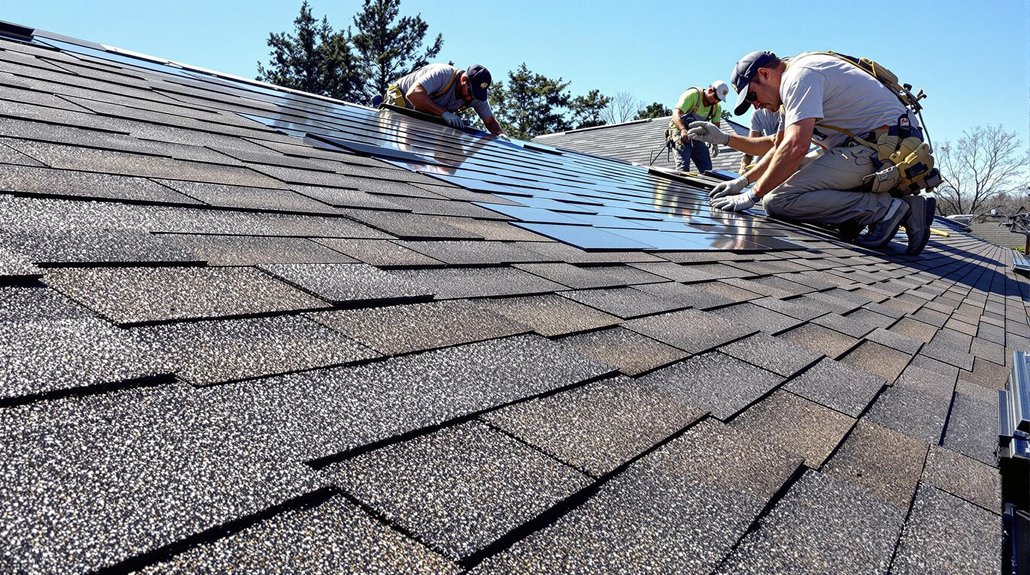
Professional installation quality and skilled workmanship stand as critical determinants in achieving the full 30-year potential of a residential roof.
Proper installation techniques, executed by certified contractors, guarantee material compatibility and structural integrity throughout the roof's intended lifespan. Quality assurance measures, including detailed inspections during installation, help prevent common issues like inadequate flashing or improper ventilation. Thorough deck inspections before installation ensure accurate budgeting and prevent future structural problems.
- Certified contractors maintain strict adherence to manufacturer guidelines and industry standards
- Regular quality control inspections identify and address potential problems during installation
- Proper material selection and compatibility testing prevent premature deterioration
- Professional workmanship guarantees extensive warranty coverage and long-term durability
These factors collectively contribute to ideal performance, reduced maintenance requirements, and enhanced durability, ultimately protecting the homeowner's investment while maximizing the roof's service life.
Essential Maintenance Practices for Maximum Longevity

Maintaining a 30-year roof requires consistent, proactive care through systematic inspection and maintenance protocols. A thorough maintenance checklist includes biannual inspections, particularly in spring and fall, to assess shingle condition, identify damage, and address potential issues before they escalate.
Essential roof upkeep practices focus on keeping gutters clear, removing debris, and preventing ice dam formation through proper insulation.
Professional maintenance programs play an important role in maximizing roof longevity. Regular expert inspections can identify hidden problems that might escape untrained observation. Key activities include cleaning roof surfaces, addressing moss and algae growth, sealing cracked mortar, and ensuring proper drainage systems.
Prompt attention to repairs, particularly when addressing leaks or damaged shingles, prevents minor issues from developing into significant structural problems.
Common Signs Your Roof Isn't Meeting Its Expected Lifespan
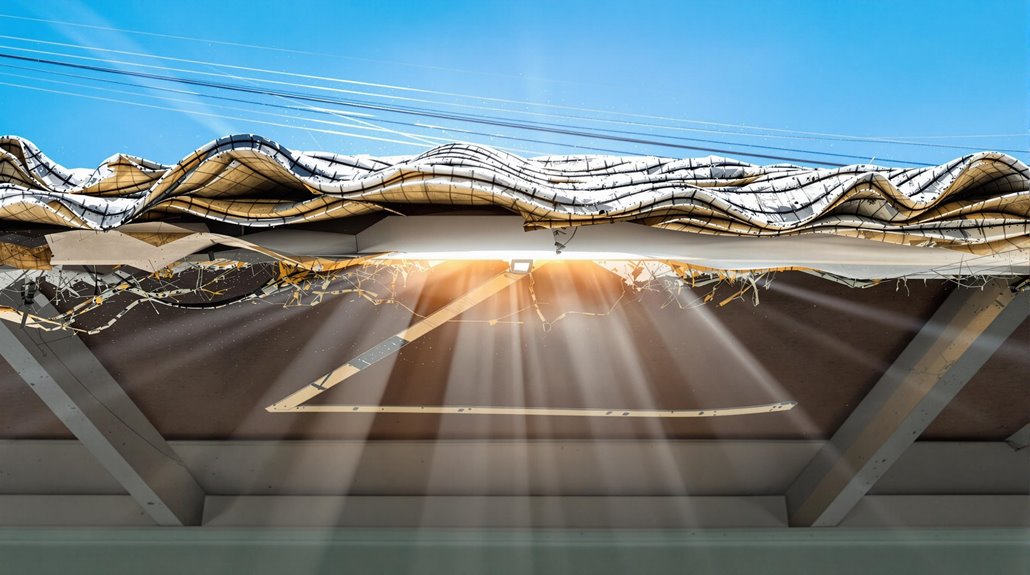
Recognizing visible aging patterns, such as curling shingles, granule loss, and discoloration, can indicate a roof's premature deterioration before its expected 30-year lifespan.
Structural warning signals, including sagging areas, interior water stains, and daylight visible through the roof deck, suggest serious underlying issues that compromise longevity.
These signs often manifest due to environmental stressors, poor installation quality, inadequate maintenance, or substandard materials, requiring immediate professional assessment to prevent further decline.
Professional roofers utilize thermal imaging technology and moisture meters to detect hidden damage that may compromise your roof's intended lifespan.
Visible Aging Patterns
A 30-year roof's premature decline often reveals itself through distinct patterns of deterioration that skilled inspectors can identify well before catastrophic failure occurs.
Regular roof inspections and adherence to maintenance schedules can catch these warning signs early, potentially extending the roof's functional lifespan.
- Shingle deterioration manifests through curling edges, granule loss, and visible cracks, typically appearing after 12-15 years of exposure.
- Structural compromise becomes evident through sagging edges, water stains on interior ceilings, and damaged flashing around vents and chimneys.
- Environmental stress indicators include ice dam formation, excessive moisture buildup from poor ventilation, and accelerated wear from extreme weather conditions.
- Surface degradation appears as widespread discoloration, missing shingles, and compromised gutter systems that no longer effectively channel water away from the roof.
Professional roof restoration services can extend your roof's lifespan at 50-70% lower cost than a complete replacement.
Structural Warning Signals
While visible aging patterns offer important clues about roof health, structural warning signals provide definitive evidence of a roof's premature decline. These damage indicators manifest through distinct physical changes that compromise roof integrity and performance.
| Warning Signal | Primary Indicator | Impact |
|---|---|---|
| Water Damage | Dark stains, damp spots | Weakened decking |
| Material Failure | Missing/curling shingles | Exposed underlayment |
| Physical Distortion | Sagging, uneven surfaces | Potential collapse |
| Energy Issues | Rising utility costs | Compromised insulation |
Professional inspectors identify these structural warning signs through thorough assessments. Sagging rooflines, soft decking, and visible water stains signal serious degradation requiring immediate attention. When combined with poor energy efficiency and persistent leaks, these indicators often reveal a roof system failing well before its 30-year projected lifespan. Public claims adjusters can help secure settlements up to 800% higher when documenting these structural deficiencies.
Comparing Different Roofing Materials and Their Durability

Different roofing materials offer varying levels of durability and longevity, with lifespans ranging from 20 to over 100 years. A thorough lifespan comparison reveals notable variations among common roofing materials, with environmental factors and maintenance playing essential roles in their durability.
- Slate tiles demonstrate superior longevity, lasting over 100 years with proper care and maintenance.
- Metal roofing systems provide exceptional durability, withstanding extreme weather for 30-50 years.
- Clay and cement tiles offer robust protection, maintaining structural integrity for 50-100 years.
- Asphalt shingles, while common, have shorter lifespans of 20-30 years, requiring more frequent replacement.
The selection of roofing materials greatly impacts a structure's long-term durability, with higher-quality materials generally providing extended service life despite higher initial costs.
Making Informed Decisions About Roof Replacement Timing
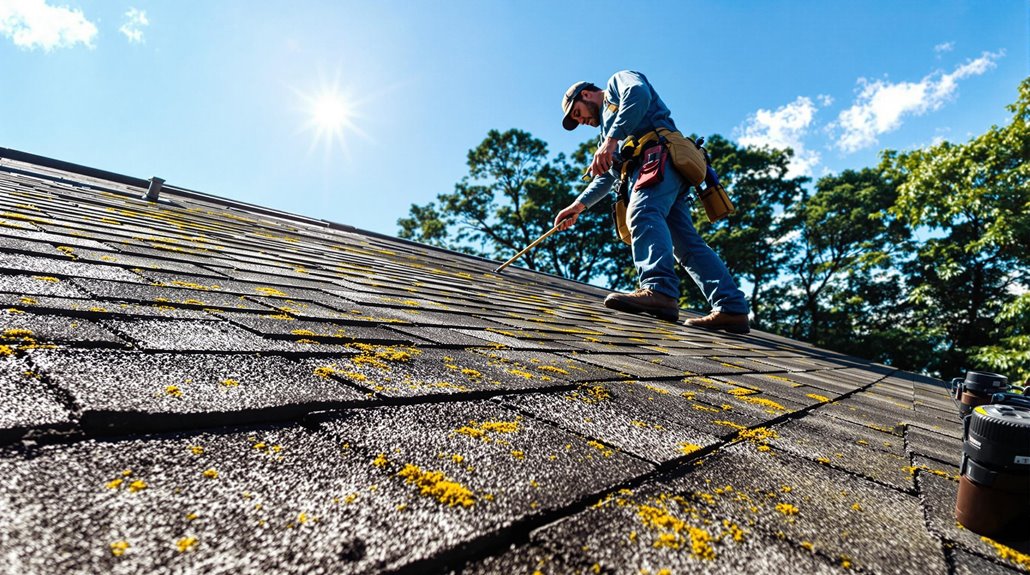
Making informed decisions about roof replacement timing requires careful evaluation of multiple critical factors that influence a roof's functional lifespan. Property owners should consider the quality of existing materials, installation standards, local climate conditions, and maintenance history when developing timing strategies for roof replacement.
Regular professional inspections can identify early warning signs and help establish realistic replacement timelines.
While a 30-year rated roof may theoretically last three decades, environmental stressors and maintenance practices greatly impact its actual longevity. In harsh climates, even premium materials might require replacement after 20-25 years. Additionally, factors such as exposure to severe weather, temperature fluctuations, and the quality of installation contribute significantly to a roof’s lifespan. Homeowners often find themselves wondering how frequently to replace a roof, as the signs of aging can vary widely based on these influences. Regular inspections and maintenance can help extend a roof’s life, ensuring that any minor issues are addressed before they escalate into more costly repairs.
Homeowners should monitor their roof's condition through routine inspections and plan for replacement before critical failures occur, considering both the manufacturer's warranty period and the roof's observed performance in local conditions.
When damage affects less than 30% of the total roof surface, repairs are often viable and more cost-effective than full replacement.
The Benefits Of Consulting A Public Adjuster

When dealing with roof damage and insurance claims, consulting a public adjuster provides valuable expertise in maneuvering complex insurance processes and ensuring objective damage assessments.
Public adjusters streamline the claims process by handling documentation, negotiations, and policy interpretation while advocating for the policyholder's interests.
Their professional knowledge and experience often result in higher claim settlements compared to self-filed claims, making their services particularly valuable for significant roof damage situations.
Studies show that claims handled by public insurance adjusters achieve settlements up to 800% higher than those filed without professional representation.
Expertise In Insurance Claims
Since managing insurance claims can be complex and overwhelming for homeowners dealing with roof damage, consulting a public adjuster offers significant advantages in the claims process.
These professionals possess extensive expertise in insurance policy interpretation and employ effective claim negotiation strategies to maximize settlements.
Public adjusters provide valuable assistance through:
- Thorough analysis of insurance policies to identify all covered damages and benefits
- Meticulous documentation and organization of damage assessments, repair estimates, and proof of loss
- Strategic negotiations with insurance companies to secure fair compensation
- Management of complex paperwork and communication, allowing homeowners to focus on recovery
Their in-depth understanding of insurance company tactics and procedures guarantees policyholders receive appropriate compensation while minimizing stress during the claims process.
Objective Damage Assessment
A thorough objective damage assessment conducted by a public adjuster provides homeowners with essential documentation and evidence needed for successful insurance claims.
Through extensive damage evaluation, these professionals examine both interior and exterior aspects of roof damage, capturing detailed photographs and preparing thorough reports.
Public adjusters guarantee neutral and impartial claim documentation by meticulously identifying all visible signs of damage and accurately estimating repair costs.
Their expertise helps prevent insurance companies from undervaluing claims while maneuvering through complex policy details. They consider multiple factors affecting damage and necessary repairs, strengthening the case for fair settlements.
This professional assessment includes detailed descriptions of damage types and extents, supported by proper documentation that maximizes the likelihood of receiving appropriate compensation for roof repairs or replacement.
Streamlined Claim Process
Public adjusters revolutionize the insurance claims process by managing every aspect from initial filing to final settlement. Their extensive claims management approach guarantees efficient processing while minimizing disruptions to policyholders' lives.
Through professional expertise and dedicated policyholder support, they handle complex documentation, coordinate inspections, and negotiate with insurance companies.
- Streamline communications by serving as the primary point of contact with insurers
- Maintain accurate documentation and meet critical deadlines
- Interpret policy language to maximize claim potential
- Deploy technology and standardized workflows to optimize efficiency
This systematic approach not only reduces stress for property owners but also increases the likelihood of favorable settlements.
Public adjusters' thorough understanding of insurance policies and industry practices enables them to navigate claims effectively while allowing policyholders to focus on recovery.
Higher Claim Payouts & Settlements
When property owners work with professional public adjusters, they consistently secure higher insurance claim settlements compared to those who handle claims independently. Through expert claim negotiations and strategic settlement strategies, public adjusters leverage their extensive knowledge of insurance policies to maximize compensation. Statistical evidence demonstrates their effectiveness, with catastrophic claims showing a 747% increase in payouts and non-catastrophic claims achieving a 574% increase when public adjusters are involved.
| Claim Type | Average Increase | Key Benefits |
|---|---|---|
| Catastrophic | 747% | Expert Damage Assessment |
| Non-Catastrophic | 574% | Professional Negotiation |
| Overall Claims | 600%+ | Maximum Policy Benefits |
This significant difference in settlement amounts stems from public adjusters' ability to conduct thorough property evaluations, identify overlooked damages, and effectively navigate complex insurance policies while advocating for policyholders' rights.
About The Public Claims Adjusters Network (PCAN)
The Public Claims Adjusters Network (PCAN) stands as a thorough insurance claims management organization dedicated to representing policyholders' interests across the globe.
With operations spanning all 50 states and five continents, PCAN delivers extensive client advocacy through their extensive network of licensed public adjusters.
- Provides expert assessment of damage while helping clients interpret complex insurance policies
- Manages the entire claims process from initial filing through final settlement
- Offers specialized support for both routine daily claims and catastrophic (CAT) events
- Maintains dedicated call centers for immediate assistance and claim status updates
This network serves both residential and commercial clients, handling diverse claims ranging from natural disasters to business interruption losses, ensuring policyholders receive maximum value from their insurance coverage while minimizing stress throughout the process.
Frequently Asked Questions
Can I Walk on My 30-Year Roof Without Causing Damage?
Walking on a residential roof requires extreme caution. While possible for necessary roof maintenance, minimize traffic and use proper walking safety techniques to prevent granule loss and structural damage.
Does Painting or Coating Asphalt Shingles Extend Their Lifespan?
Painting asphalt shingles typically reduces their effectiveness and voids warranties. While coatings may enhance roof aesthetics, they're not recommended for long-term shingle maintenance and can potentially accelerate deterioration.
How Do Solar Panel Installations Affect My Roof's Warranty?
Solar panel installations can void roof warranties if not properly coordinated with roofing manufacturers and installed correctly. Professional installation and documentation of warranty terms are essential for maintaining coverage.
Are Dark or Light-Colored Shingles Better for Roof Longevity?
Light-colored shingles typically offer better longevity, particularly in warmer regions, by reflecting heat and reducing thermal stress. However, ideal shingle material selection should primarily consider local climate impact and ventilation requirements.
Can Upgrading Attic Ventilation Extend the Life of Existing Shingles?
Enhanced attic airflow through upgraded ventilation systems can greatly extend shingle life by reducing heat buildup, preventing moisture accumulation, and maintaining ideal roof temperatures throughout seasonal changes.
References
- https://lintaroofing.com/blog/do-30-year-shingles-last-30-years
- https://premiersystemsroofing.com/blog/7-factors-that-affect-how-long-your-roof-lasts/
- https://my-pittsburghroofing.com/blog/30-year-roofing-myth-busted-how-long-does-a-30-year-roof-really-last/
- https://www.jandmroofing.com/resource/what-is-the-average-lifespan-of-a-shingle-roof/
- https://garciadidmyroof.com/blog/roof-lifespan-factors/
- https://www.youtube.com/watch?v=wwW1s8ouiGQ
- https://modernexteriorsystems.com/what-is-year-warranty-on-roof
- https://provenroofing.com/what-is-the-difference-between-30-year-and-50-year-shingles/
- https://ibsroofing.com/resources/what-every-property-owner-needs-to-know-about-commercial-roof-warranty/
- https://www.newheightsroof.com/blog/understanding-the-difference-between-30-year-and-50-year-shingles
